Abstract
In this article, we apply the singularity structure analysis to test an extended 2+1-dimensional fifth-order KdV equation for integrability. It is proven that the generalized equation passes the Painlevé test for integrability only in three distinct cases. Two of those cases are in agreement with the known results, and a new integrable equation is first given. Then, for the new integrable equation, we employ the Bell polynomial method to construct its bilinear forms, bilinear Bäcklund transformation, Lax pair, and infinite conversation laws systematically. The N-soliton solutions of this new integrable equation are derived, and the propagations and collisions of multiple solitons are shown by graphs.
1 Introduction
In the past decades, many powerful methods to solve integrable systems, such as the inverse scattering transformations (ISTs), Darboux transformations, Bäcklund transformations (BTs), symmetry reduction, Hirota bilinear method, and Painlevé analysis method, have been developed [1]. The usual real physical nonlinear systems can be treated as perturbations of the related integrable models. It is an interesting task to generate new integrable equations in the soliton theory.
Painlevé analysis method has been identified as one of the most effective tools in studying nonlinear evolution equations (NLEEs) [2]. This analysis not only can verify whether a given equation possesses the Painlevé property, but it also can search for all possible integrable cases of a NLEEs with general forms [3–9]. Moreover, the remarkable feature of Painlevé analysis is that a natural connection exists in relation to many integrable properties such as Hirota bilinear forms, Lax pairs, BTs, and various types of exact solutions [10–15]. Hirota bilinear method is a direct method to derive the multiple-soliton solutions, quasi-periodic wave solutions, bilinear BT, and other properties of a given NLEEs [16–19]. The crucial step of this method relies on a particular skill by choosing suitable variable transformations, but there is no general rule to find the transformations. Using the links between the Bell polynomials and Hirota D-operators, Lambert and his coworkers have established a direct method to derive bilinear forms, bilinear BT and Lax pairs of soliton equations systematically [20, 21]. The Bell polynomials approach has been extended to the variable-coefficient, supersymmetric, and discrete NLEEs [22–39].
In this work, we will employ the Painlevé analysis and Bell polynomial method to study an extended fifth-order Korteweg–de Vries (KdV) equation
which is an important higher-order extension of the famous KdV equation in fluid dynamics. The KdV-type equations have been widely recognized as ubiquitous mathematical models for describing some nonlinear phenomena in many branches o f physics. The higher-order dispersion and nonlinear terms must be taken into account in some complicated situations such as the surface and internal waves, gravity–capillary waves, longitudinal waves in microstructured solids, and so on. In (1), u=u(x, y, t) and λj(j=1, …, 8) are real parameters. Much research has been done for its particular cases. However, the integrability of the generalized equation (1) has not been investigated.
Equation (1) includes a number of important NLEEs as its special cases. Konopelchenko and colleagues [40, 41] constructed and studied two integrable equations:
which are the (2+1)-dimensional integrable generalization of the Sawada–Kotera (SK) equation and the Kaup–Kuperschmidt (KK) equation, respectively. The Lax pair, conservation laws, symmetry structure, and multiple-soliton solutions of (2) and (3) have been investigated in [42–44].
When λ1=1/36, λ2=λ3=5/12, λ4=5/4, λ5=λ6=–5/36, λ7=λ8=–5/12, (1) reduces to the (2+1)-dimensional Caudrey–Dodd–Gibbon–Kotera–Sawada equation:
Its symmetry constraints and quasi-periodic solutions have been constructed [45, 46].
When λ1=1/9, λ2=5/3, λ3=25/6, λ4=5, λ5=–λ6=–5σ/9, λ7=λ8=5σ/3, (1) reduces to the (2+1)-dimensional KK equation with another form:
Its multiple-soliton solutions and symmetry algebras have been presented [47].
Using gauge transformation, He and Li [48] studied two other particular cases of (1):
Up to now, we have already known that (2)–(7) are integrable. The natural and important question is under what constraints on parameters λj (j=1, …, 8) is (1) integrable, i.e. does another new integrable subcase of (1) exist? In the following section, we will perform the Painlevé test for the extended equation (1) to derive all possible integrable subcases. In Section 3, by employing the Bell polynomials method, we systematically construct the bilinear forms, bilinear BT and Lax pair for the new integrable equation. In Section 4, the N-soliton solutions and their collisions are discussed. Some conclusions are given in the final section.
2 Integrability Test
To verify whether a given NLEEs possesses the Painlevé property, one may use different methods, such as the Weiss–Tabor–Carnevale (WTC) method, Kruskal’s simplification for the WTC method, Conte invariant method, Lou’s extended method, and so on. Here we apply the WTC–Kruskal’s approach to carry out the Painlevé integrability test for (1). Taking uy=vx, (1) becomes the following coupled system:

To simplify the calculations, the Kruskal’s ansatz ϕ(x, y, t)=x+ψ(y, t) is adopted here.
Inserting
To determine the resonant points, we set
Substituting the truncated expansions into the dominant terms of (8) yields a polynomial equation in j,
where u0 is given by (9). From (10), we know that three resonant points occur at –1, 2, 6. Other three undetermined resonances, say j1, j2, j3, must be integers, and this is possible if
Solving the first equation of (11) yields j3=15–j1–j2. The considered branch should be generic, i.e. five resonant points lie in positive integer positions. Then the positive integer conditions for j1, j2, j3 result in 16 different subcases: (1) [1, 1, 13], (2) [1, 2, 12], (3) [1, 3, 11], (4) [1, 4, 10], (5) [1, 5, 9], (6) [1, 6, 8] (7) [1, 7, 7], (8) [2, 3, 10], (9) [2, 4, 9], (10) [2, 5, 8], (11) [2, 6, 7], (12) [3, 3, 9], (13) [3, 4, 8], (14) [3, 5, 7], (15) [4, 4, 7], (16) [4, 5, 6].
Testing all the resonant conditions for subcases (1)–(16) yields possible Painlevé integrable models under some constraints on parameters λj. For instance, for case (10), solving (9) and (11) with respect to λ1, λ2, λ3, u0, and v0 will lead to
Six resonant points occur at –1, 2, 2, 5, 6, 8. To test the resonant conditions, one may take
Inserting expansions (13) into (8) and setting the coefficients of {ϕ−6, ϕ−2} to zero, we get u1=v1=0.
For j=2, collecting the coefficients of {ϕ−5, ϕ−1} will lead to
where parameter λ1 cannot be taken as zero, thus condition (14) is satisfied if and only if
For j=3 and j=4, setting the coefficients of {ϕ−4, ϕ0} and {ϕ−3, ϕ1} to zero, we get
For j=5, the corresponding resonant condition is obtained as
where parameter λ1 cannot be taken as zero; thus, condition (16) is consistent if and only if
Together with conditions (12), (15), and (17), the final parametric constraints read
Under constraints (18), the coefficients u2, v2, u5, u6, u8, ψ in (13) are arbitrary functions of {y, t}, which indicate that the conditions at all non-negative resonant points are verified and the remaining coefficients in (13) are
Under parameter constraints (18), there is another secondary branch for (8). For the secondary branch, the leading order analysis leads to α1=α2=–2, u0=–40λ1/λ3, v0=–40λ1ψy/λ3. Six resonant points occur at –3, –1, 2, 6, 8, and 10. To verify the resonant conditions, we suppose
Substituting it into (8) and collecting the different powers of ϕ will lead to
where the coefficients v2, u6, u8, u10 in (19) are arbitrary functions of {y, t}.
The above analysis for case (10) yields the first type of integrable model.
Integrable model I (new integrable model):
where parameters λ1 and λ3 are arbitrary nonzero constants.
Performing the similar analysis for other cases, one can obtain other two integrable subcases of (1). For simplicity, the detailed computations are omitted.
Integrable model II (2+1-dimensional generalized SK equation):
where parameters λ1 and λ3 are arbitrary nonzero constants. For model (21), there is a primary branch with the resonances located at {–1, 2, 2, 3, 6, 10} and a secondary branch with the resonances located at {–2, –1, 2, 5, 6, 12}, and all the resonant conditions are consistent.
Integrable model III (2+1-dimensional generalized KK equation):
where parameters λ1 and λ3 are arbitrary nonzero constants. For model (22), there is a primary branch with the resonances located at {–1, 2, 3, 6, 7} and a secondary branch with the resonances located at {–7, –1, 2, 6, 10, 12}, and all the resonant conditions are consistent.
If we take appropriate values for λj (j=1, 3, 5), (21) and (22) can be reduced to the particular cases (2)–(7), which are exactly the 2+1-dimensional integrable generalizations of the SK and KK equations, respectively. Equation (20) is a new fifth-order integrable model in 2+1 dimensions and has not been reported in literature.
3 Bell Polynomials Method for (20)
In this section, we will employ the Bell polynomials method to study the new integrable equation (20).
3.1 The Bilinear Representation and N-Soliton Solutions
The standard Painlevé truncated expansion of (20) reads as
where ϕ=ϕ(x, y, t) and u2 is the seed solution. First, we set q=2ln ϕ and u2=0. Then applying transformation (23) into (20) and integrating once with respect to x, one gets
which can be rewritten as
To write (25) as the combination of 𝒫 -polynomial expression, one may introduce an auxiliary variable z and impose a subsidiary constraint condition
Via the transformation q=2 lnϕ, the 𝒫 -polynomial system (26) produces the bilinear forms
Based on the bilinear representation (27), the N-soliton solutions of (20) can be expressed as
where
3.2 BT and Lax Pair
Following the procedure in [11], one can find the bilinear BT and Lax pair for (20). To this end, let q̅=2lnG and q=2lnF be two different solutions of (24), respectively, and we then have
which can be regarded as an ansatz for a bilinear BT under some constraints. To find such constraint, by letting (q̅–q)/2=v, (q̅+q)/2=w, we obtain
where
If we take
one can obtain a linear system in term of 𝒴 -polynomials
Then, a new BT of (20) is obtained as follows
By introducing the transformations v=lnψ and w=v+q, (31) can be reduced to the linear system,
whose integrability condition gives (20) by replacing qxx by λ3u/20λ1, which indicates that system (33) can be regarded as the Lax pair of (20).
3.2.1 Infinite Conservation Laws
By introducing a new potential function η=(q̅x–qx)/2, one can get the relations
Substituting (34) into the system (31) will lead to a Riccati-type equation,
and a divergence-type equation,
where we have used (35) to obtain (36).
Next, we take η=η̅+ε and μ=ε2, then (35) and (36) reduce to
Inserting the expansion
into (37), and equating the coefficients for power of ε, we obtain the recursion formulae for ℐn
The first and second conserved densities turn out to be
Subsequently, inserting expansion (39) into (38) yields
where the first fluxes ℱn read as
and the second fluxes 𝒢n are given by
The first equation of conservation law (40) is just the new integrable model (20).
4 Interactions of Multiple Solitons
From (28), the one-soliton solution reads
where parameters k1, l1, and ξ0 are arbitrary constants. The profile of the one-soliton via solution (41) is shown in Figure 1. It can be seen that the soliton amplitude increases with the increase of k1 while other parameters are fixed.
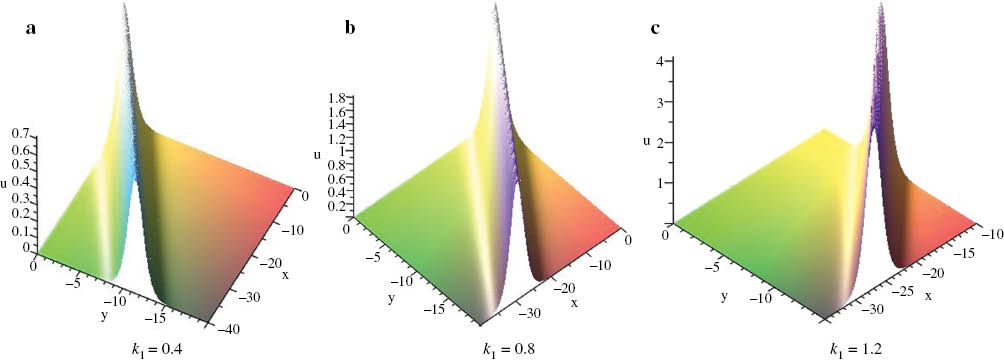
One soliton given by expression (41) with λ1=2.2, λ3=7.6, λ5=2, l1=0.8, ξ10=0.
The two-soliton solution can be written as
By selecting appropriate parameter values via solution (42), four different types of collisions of two solitary waves are shown in Figures 2–5. Elastic overtaking collisions of two solitary waves are illustrated in shown in Figures 2 and 3. Figure 2 show that two solitary waves are left-going along the x-axis and the smaller-amplitude soliton moves faster and then overtakes the larger. After the collision, the wave shapes and velocities remain unchanged. Figure 3 shows that two solitary waves are right-going along the y-axis and the larger-amplitude soliton overtakes the smaller one. The head-on collision of two solitary waves along opposite directions is depicted in Figure 4. When k1=k2, l1≠l2, V-type collisions occur, as shown in Figure 5.
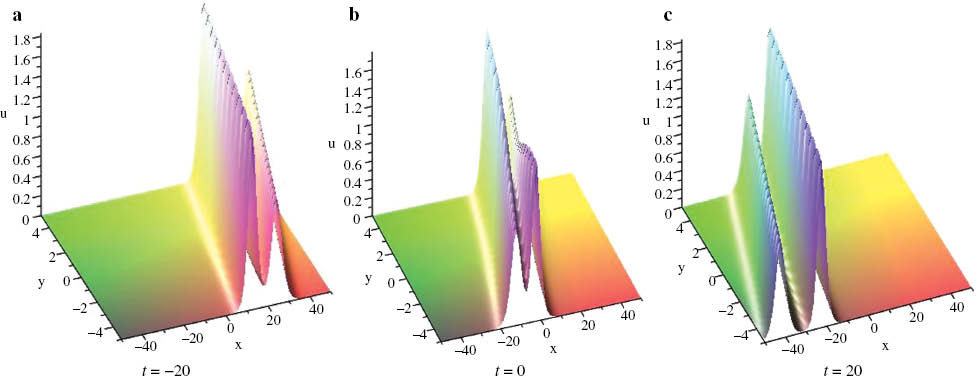
The overtaking collision of two solitary waves given by (42), where λ1=2.2, λ3=7.6, λ5=2, k1=0.6, k2=0.8, l1=–1.5, l2=–1.2, ξ10=ξ20=0.
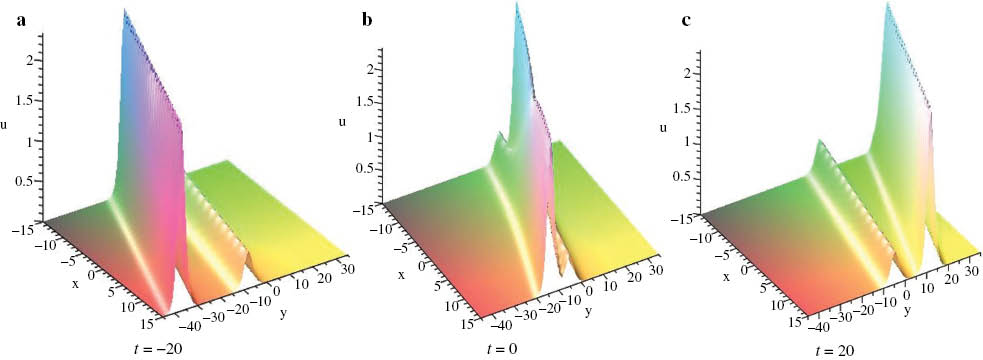
The overtaking collision of two solitary waves given by (42), where λ1=2.2, λ3=7.6, λ5=2, k1=0.6, k2=0.9, l1=0.8, l2=1.0, ξ10=ξ20=0.
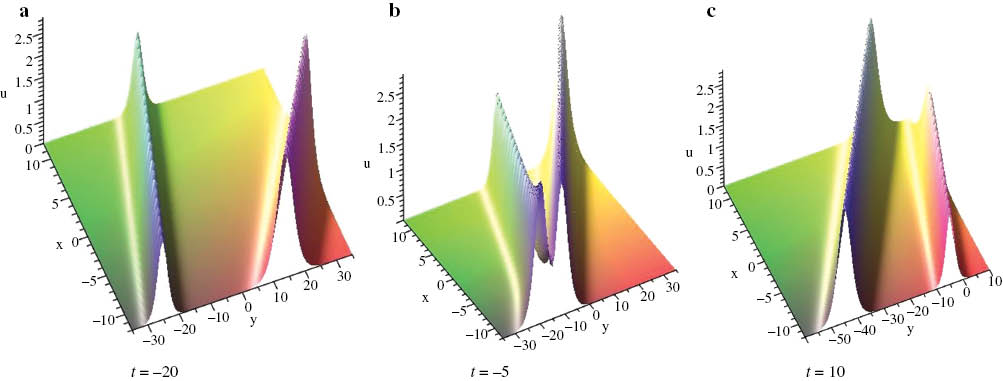
The headon collision of two solitary waves given by (42), where λ1=2.2, λ3=7.6, λ5=2, k1=1.0, k2=0.6, l1=–0.5, l2=–1.5, ξ10=ξ20=0.
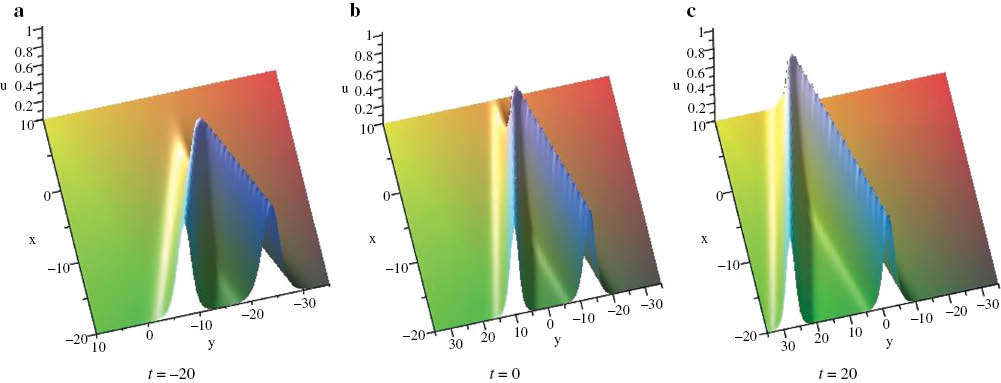
The V-type collision of two solitary waves given by (42), where λ1=2.2, λ3=7.6, λ5=2, k1=k2=0.6, l1=–1.15, l2=–0.9, ξ10=ξ20=0.
More interesting collisions of three solitary wave can be exhibited by graphs. For the sake of simplicity, here, only the overtaking collisions and head-on collisions are shown in Figures 6 and 7, respectively.
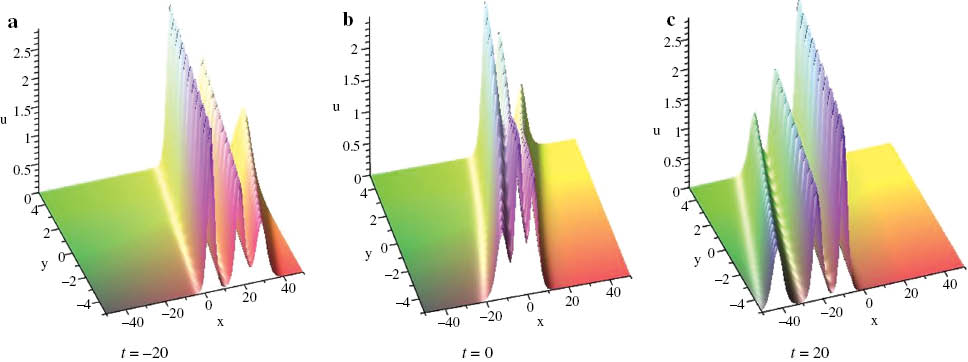
The overtaking collision of three solitary waves given by (28), where N=3, λ1=2.2, λ3=7.6, λ5=2, k1=0.6, k2=0.8, k3=1.0, l1=–1.5, l2=–1.2, l2=–1.35, ξ10=ξ20=ξ30=0.

The head-on collision of three solitary waves given by (28), where N=3, λ1=2.2, λ3=7.6, λ5=2, k1=0.8, k2=1.0, k3=0.6, l1=–0.1, l2=–0.5, l3=–1.5, ξ10=ξ20=ξ30=0.
5 Conclusions
Using the WTC–Kruskal method and symbolic computation, we performed the Painlevé test for an extended 2+1-dimensional fifth-order KdV equation. Three distinct cases that pass the Painlevé test have been found, and two of those cases correspond to the generalizations of the integrable equations (2)–(7), whereas the first one turns out to be new.
For the new integrable model (20), we employed the Bell polynomials method to further prove its integrability. As a result, we derived the bilinear forms, bilinear BT, Lax pair, and infinite conservation laws systematically. Moreover, we also obtained the N-soliton solutions of the new obtained model. The collisions of multiple solitons have been discussed, which include overtaking, head-on as well as V-type collisions. Further studies on other integrable properties and exact solutions of this new unnamed model should be done in the future.
Acknowledgments
This work was supported by the National Natural Science Foundation of China under grants 11201290 and 11301183.
References
[1] M. J. Ablowitz and P. A. Clarkson, Solitons, Nonlinear Evolution Equations and Inverse Scattering, Cambridge University Press, Cambridge 1991.10.1017/CBO9780511623998Suche in Google Scholar
[2] J. Weiss, M. Tabor, and G. Carnevale, J. Math. Phys. 24, 522 (1983).10.1063/1.525721Suche in Google Scholar
[3] W. H. Steeb and N. Euler, Nonlinear Evolution Equations and Painlevé Test, World Scientific, Singapore 1988.10.1142/0723Suche in Google Scholar
[4] G. Q. Xu and Z. B. Li, Comput. Phys. Commun. 161, 65 (2004).10.1016/j.cpc.2004.04.005Suche in Google Scholar
[5] G. Q. Xu, Phys. Rev. E 74, 027602 (2006).10.1103/PhysRevE.74.027602Suche in Google Scholar PubMed
[6] G. Q. Xu, Comput. Phys. Commun. 178, 505 (2008).10.1016/j.cpc.2007.11.006Suche in Google Scholar
[7] G. Q. Xu, Comput. Phys. Commun. 180, 1137 (2009).10.1016/j.cpc.2009.01.019Suche in Google Scholar
[8] G. Q. Xu, Chin. Phys. B 22, 050203 (2013).10.1088/1674-1056/22/5/050203Suche in Google Scholar
[9] G. Q. Xu, Phys. Scripta 89, 125201 (2014).10.1088/0031-8949/89/12/125201Suche in Google Scholar
[10] A. Pickering, J. Phys. A: Math. Gen. 26, 4395 (1993).10.1088/0305-4470/26/17/044Suche in Google Scholar
[11] A. Pickering, J. Math. Phys. 35, 821 (1994).10.1063/1.530615Suche in Google Scholar
[12] S. Y. Lou, Z. Naturforsch. 53a, 251 (1998).10.1515/zna-1998-0523Suche in Google Scholar
[13] X. P. Cheng, C. L. Chen, and S. Y. Lou, Wave motion 51, 1298 (2014).10.1016/j.wavemoti.2014.07.012Suche in Google Scholar
[14] S. Y. Lou, Stud. Appl. Math. 134, 372 (2015).10.1111/sapm.12072Suche in Google Scholar
[15] Y. J. Ye, D. D. Zhang, and Y. M. Di, Z. Naturforsch. 70a, 823 (2015).10.1515/zna-2015-0248Suche in Google Scholar
[16] R. Hirota, The Direct Method in Soliton Theory, Cambridge University Press, Cambridge 2004.10.1017/CBO9780511543043Suche in Google Scholar
[17] S. F. Deng, Phys. Lett. A 362, 198 (2007).10.1016/j.physleta.2006.10.008Suche in Google Scholar
[18] S. F. Deng and Z. Y. Qin, Phys. Lett. A 372, 5426 (2008).10.1016/j.physleta.2008.06.052Suche in Google Scholar
[19] S. F. Deng, Appl. Math. Comput. 218, 5974 (2012).10.1016/j.amc.2011.11.076Suche in Google Scholar
[20] F. Lambert, I. Loris, and J. Springael, Inverse Probl. 17, 1067 (2001).10.1088/0266-5611/17/4/333Suche in Google Scholar
[21] F. Lambert and J. Springael, Acta Appl. Math. 102, 147 (2008).10.1007/s10440-008-9209-3Suche in Google Scholar
[22] E. G. Fan, Phys. Lett. A 375, 493 (2011).10.1016/j.physleta.2010.11.038Suche in Google Scholar
[23] E. G. Fan, Stud. Appl. Math. 127, 284 (2011).10.1111/j.1467-9590.2011.00520.xSuche in Google Scholar
[24] E. G. Fan and Y. C. Hon, J. Math. Phys. 53, 013503 (2012).10.1063/1.3673275Suche in Google Scholar
[25] Y. Zhang, W. W. Wei, T. F. Cheng and Y. Song, Chin. Phys. B 20, 110204 (2011).10.1088/1674-1056/20/11/110204Suche in Google Scholar
[26] W. X. Ma, Front. Math. China 8, 1139 (2013).10.1007/s11464-013-0319-5Suche in Google Scholar
[27] W. X. Ma, Rep. Math. Phys. 72, 41 (2013).10.1016/S0034-4877(14)60003-3Suche in Google Scholar
[28] Y. F. Zhang and H. Tam, J. Math. Phys. 54, 013516 (2013).10.1063/1.4788665Suche in Google Scholar
[29] Y. F. Zhang, Z. Hang, H. Tam, Commun. Theor. Phys. 59, 671 (2013).10.1088/0253-6102/59/6/03Suche in Google Scholar
[30] Y. H. Wang and Y. Chen, J. Math. Anal. Appl. 400, 624 (2013).10.1016/j.jmaa.2012.11.028Suche in Google Scholar
[31] Q. Miao, Y. H. Wang, Y. Chen, and Y. Q. Yang, Comput. Phys. Commun. 185, 357 (2014).10.1016/j.cpc.2013.09.005Suche in Google Scholar
[32] S. F. Tian and H. Q. Zhang, J. Phys. A: Math. Theor. 45, 055203 (2012).10.1088/1751-8113/45/5/055203Suche in Google Scholar
[33] S. F. Tian and H. Q. Zhang, Stud. Appl. Math. 132, 212 (2014).10.1111/sapm.12026Suche in Google Scholar
[34] L. Luo, Z. Qiao, and J. Lopez, Phys. Lett. A 378, 677 (2014).10.1016/j.physleta.2013.11.029Suche in Google Scholar
[35] Y. H. Sun, Y. T. Gao, G. Q. Meng, X. Yu, Y. J. Shen, et al., Nonlinear Dyn. 78, 349 (2014).10.1007/s11071-014-1444-8Suche in Google Scholar
[36] D. W. Zuo, Y. T. Gao, Y. H. Sun, Y. J. Feng and L. Xue, Z. Naturforsch. 69a, 521 (2014).10.5560/zna.2014-0045Suche in Google Scholar
[37] G. Q. Xu, Appl. Math. Lett. 50, 16 (2015).10.1016/j.aml.2015.05.015Suche in Google Scholar
[38] A. M. Wazwaz and G. Q. Xu, Math. Method Appl. Sci. 39, 661 (2016).10.1002/mma.3507Suche in Google Scholar
[39] O. Unsal and F. Tascan, Z. Naturforsch. 70a, 359 (2015).10.1515/zna-2015-0076Suche in Google Scholar
[40] B. G. Konopelchenko and V. G. Dubrovsky, Phys. Lett. A 102, 15 (1984).10.1016/0375-9601(84)90442-0Suche in Google Scholar
[41] V. G. Dubrovsky, Ya. V. Lisitsyn, Phys. Lett. A 295, 198 (2002).10.1016/S0375-9601(02)00154-8Suche in Google Scholar
[42] M. C. Nucci, J. Phys. A: Math. Gen. 22, 2897 (1989).10.1088/0305-4470/22/15/009Suche in Google Scholar
[43] Y. H. Wang and Y. Chen, Commun. Theor. Phys. 56, 672 (2011).10.1088/0253-6102/56/4/14Suche in Google Scholar
[44] X. Lü, Nonlinear Dyn. 76, 161 (2014).10.1007/s11071-013-1118-ySuche in Google Scholar
[45] Y. Chen and Y. S. Li, J. Phys. A: Math. Gen. 25, 419 (1992).10.1088/0305-4470/25/2/022Suche in Google Scholar
[46] C. W. Cao, Y. T. Wu, and X. G. Geng, Phys. Lett. A 256, 59 (1999).10.1016/S0375-9601(99)00201-7Suche in Google Scholar
[47] X. B. Hu, D. L. Wang, and X. M. Qian, Phys. Lett. A 262, 409 (1999).10.1016/S0375-9601(99)00683-0Suche in Google Scholar
[48] J. S. He and X. D. Li, J. Nonlinear Math. Phys. 16, 179 (2009).10.1142/S1402925109000170Suche in Google Scholar
©2016 by De Gruyter
Artikel in diesem Heft
- Frontmatter
- Spinless Particle in a Magnetic Field Under Minimal Length Scenario
- Constraint on the Multi-Component CKP Hierarchy and Recursion Operators
- Band Structure Characteristics of Nacreous Composite Materials with Various Defects
- The Integrability of an Extended Fifth-Order KdV Equation in 2+1 Dimensions: Painlevé Property, Lax Pair, Conservation Laws, and Soliton Interactions
- Numerical Solution for the Effect of Suction or Injection on Flow of Nanofluids Past a Stretching Sheet
- First-Principles Calculations of the Mechanical and Elastic Properties of 2Hc- and 2Ha-WS2/CrS2 Under Pressure
- Conservation Laws and Mixed-Type Vector Solitons for the 3-Coupled Variable-Coefficient Nonlinear Schrödinger Equations in Inhomogeneous Multicomponent Optical Fibre
- Classical Equation of State for Dilute Relativistic Plasma
- Magnetic Field and Slip Effects on the Flow and Heat Transfer of Stagnation Point Jeffrey Fluid over Deformable Surfaces
- Nonlocal Symmetry and its Applications in Perturbed mKdV Equation
- Universality of the Phonon–Roton Spectrum in Liquids and Superfluidity of 4He
Artikel in diesem Heft
- Frontmatter
- Spinless Particle in a Magnetic Field Under Minimal Length Scenario
- Constraint on the Multi-Component CKP Hierarchy and Recursion Operators
- Band Structure Characteristics of Nacreous Composite Materials with Various Defects
- The Integrability of an Extended Fifth-Order KdV Equation in 2+1 Dimensions: Painlevé Property, Lax Pair, Conservation Laws, and Soliton Interactions
- Numerical Solution for the Effect of Suction or Injection on Flow of Nanofluids Past a Stretching Sheet
- First-Principles Calculations of the Mechanical and Elastic Properties of 2Hc- and 2Ha-WS2/CrS2 Under Pressure
- Conservation Laws and Mixed-Type Vector Solitons for the 3-Coupled Variable-Coefficient Nonlinear Schrödinger Equations in Inhomogeneous Multicomponent Optical Fibre
- Classical Equation of State for Dilute Relativistic Plasma
- Magnetic Field and Slip Effects on the Flow and Heat Transfer of Stagnation Point Jeffrey Fluid over Deformable Surfaces
- Nonlocal Symmetry and its Applications in Perturbed mKdV Equation
- Universality of the Phonon–Roton Spectrum in Liquids and Superfluidity of 4He

